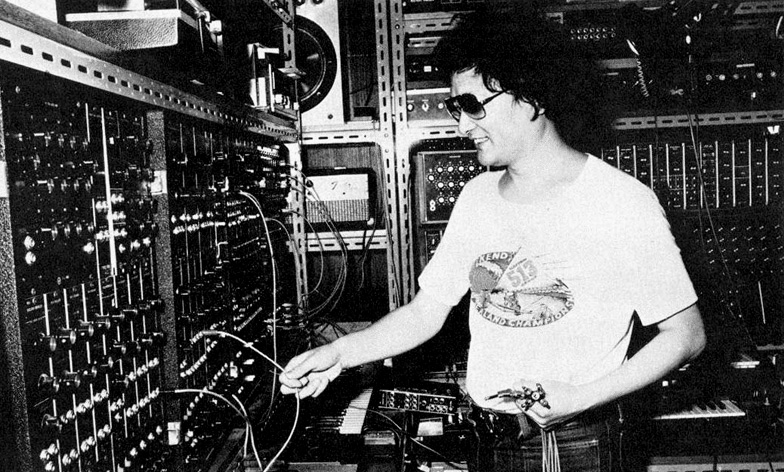Last week, the Japanese composer and master synthesist Isao Tomita sadly passed away at the age of 84. He was known worldwide for his electronic arrangements of classical compositions, with which he followed in the footsteps of synthesists Wendy Carlos and Rachel Elkind, creators of the 1968 LP Switched on Bach and the soundtrack to Stanley Kubrick’s A Clockwork Orange. Tomita’s pioneering use of the Moog III and his layering of monophonic sound sources to achieve polyphony were what gave his arrangements of Debussy, Ravel and Stravinsky such intrigue and popular appeal, while his combined understanding of orchestral composition and sound modulation enabled him to give movement and dynamic variation to his music, in a way that Carlos never managed.
To some these records are seen as a novelty items, but what cannot be denied is Tomita’s masterful understanding of the synthesizer and it’s boundless potential. The sound palette of albums like Pictures at an Exhibition are so broad, that elements like the synthesised voice are recognisable in ’80s popular music, whereas the sequenced, FM percussion sounds bare a striking resemblance to the textures of ’90s techno; styles that occured long after Tomita’s first work.
His GRAMMY® nominated 1974 release Snowflakes are Dancing exposed him to new audiences, and with that came distribution which placed his records in locations all around the world, where they then had significant impacts on the next generation of creatives.
The first and most obvious influence Tomita had was on the Japanese synthesizer enthusiasts that suceeded him. In being one of the very first independent musician to import a Moog III synthesizer into Japan at tremendous personal cost, he quickly attracted an understudy in the form of Hideki Matsutake, who assisted him on his intensive early works, before joining Yellow Magic Orchestra with Ryuichi Sakamoto, another individual notably influenced by Tomita, and becoming key to the synth pop movement of the late ’70s. Japanese new age composers like Kitarō, would’ve undoubtably been influenced by the ambient washes that Tomita created in his studio albums, film scores and commercial music, as it slipped into the lives of consumers, and laid the blueprints for the soundscape styles that were to follow.
The second wave of influence was on a vast array of U.S. musicians, ranging from funk and soul artists like Stevie Wonder, who credited Tomita for turning him on to several classical composers, to hip hop producers like J Dilla, Black Milk and Flying Lotus who discovered Tomita’s music through exhaustively “digging“. They all utilised Tomita’s music in their productions, recognising a compatibility between their progressive beats and Tomita’s melodic works. As a result, Tomita can be heard behind rappers as diverse Slum Village, Guilty Simpson, Busta Rhymes and Earl Sweatshirt. Further to this, Tomita was once visited at his studio by Michael Jackson during his 1987 tour of Japan, with the two socialising and playing synths together, apparently discussing plans to collaborate, although those never materialised.
But the final, and perhaps most pure of Tomita’s influences is on the individuals of the self-contained noise scene in Tampa, Florida. This lost clip from the Far Off Sounds film which documents the scene, tells the tale of how a group of school kids discovered Tomita’s music on a unmarked tape they found discarded near their school yard, and how they spent years attempting to emulate the music and identify it’s creator. It’s interesting to see how they interpreted Tomita’s music, knowing nothing of it’s origins and having no way to contextualise it, as well as how it led to them to creating a music which is brazen and esoteric, rather than melodic and accessible. This is a true indication of how widespread Tomita’s influence really is, and how significant his music has been on music that has followed.
In Tomita’s 2014 Red Bull Music Academy lecture, he provides an insight into his early work, and explains how he started emulating musical instruments with the synthesizer, leading to the creation of Snowflakes are Dancing.
RIP to one of my favorites. Isao Tomita. Have been enjoying the music so much these past few weeks. Legend!! Snowflakes are dancing❤️
— FLYLO (@flyinglotus) May 8, 2016
Very sorry to hear about this: such beautiful sounds, and painstaking work: Isao Tomita dies at 84 The Japan Times https://t.co/l9BXGK3KBl
— Jonny Greenwood (@JnnyG) May 9, 2016
In tribute to his passing Tomita’s Snowflakes Are Dancing, an obsession of the 14 yr old me, is our feat album on next weeks Freak Zone
— Stuart Maconie (@StuartMaconie) May 9, 2016
Thankful for Isao Tomita’s inspiring, imaginative words in Tokyo. He will be dearly missed. https://t.co/HC6LUBEOMa pic.twitter.com/m3Xce2JIEs
— RedBullMusicAcademy (@RBMA) May 8, 2016



